AI Policy And Standards Market Size 2025-2029
The AI policy and standards market size is valued to increase by USD 377.8 million, at a CAGR of 38.6% from 2024 to 2029. Proliferation of generative AI and management of societal risks will drive the ai policy and standards market.
Major Market Trends & Insights
- North America dominated the market and accounted for a 44% growth during the forecast period.
- By Component - Solutions segment was valued at USD 14.50 million in 2023
- By Deployment - Cloud-based segment accounted for the largest market revenue share in 2023
Market Size & Forecast
- Market Opportunities: USD 1.00 million
- Market Future Opportunities: USD 377.80 million
- CAGR from 2024 to 2029 : 38.6%
Market Summary
- The market is experiencing significant growth as the global community grapples with the societal implications of artificial intelligence (AI). Ethical considerations and risk management have emerged as critical priorities, leading to a shift from abstract principles to practical governance mechanisms. According to recent estimates, the global AI ethics market is projected to reach USD 10.3 billion by 2026, underscoring the market's expanding importance. The operationalization of ethics in AI policy and standards poses unique challenges. The rapid technological evolution of AI outpaces deliberative policy cycles, necessitating a more agile and adaptive approach to governance. Proactive engagement from stakeholders, including governments, industry leaders, and civil society, is essential to ensure that AI is developed and deployed responsibly.
- The proliferation of generative AI and its potential impact on society necessitates a robust regulatory framework. Ethical guidelines and standards are necessary to mitigate risks, protect privacy, and promote transparency. However, creating and enforcing these standards requires a collaborative effort from all stakeholders, including AI developers, policymakers, and the public. The market represents a dynamic and complex landscape. Its evolution reflects the ongoing dialogue between technological innovation and societal values. As AI continues to reshape industries and transform our world, the importance of effective policy and standards will only grow.
What will be the Size of the AI Policy And Standards Market during the forecast period?
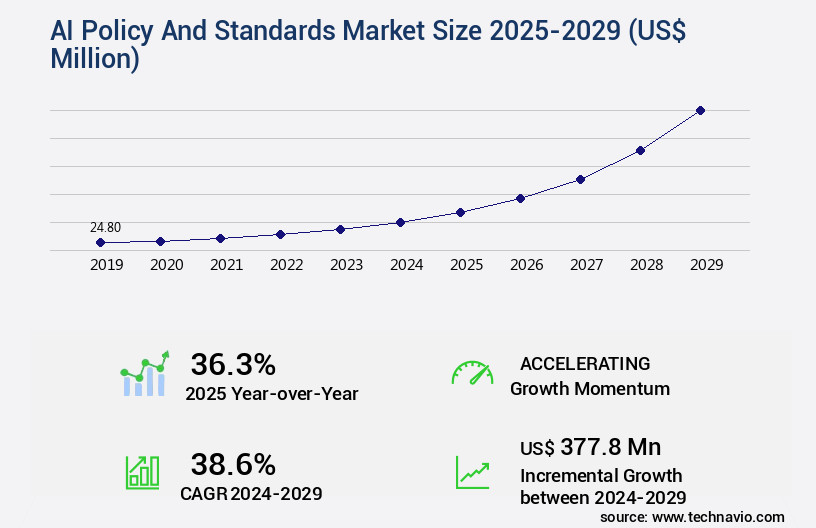
Get Key Insights on Market Forecast (PDF) Request Free Sample
How is the AI Policy And Standards Market Segmented ?
The AI policy and standards industry research report provides comprehensive data (region-wise segment analysis), with forecasts and estimates in "USD million" for the period 2025-2029, as well as historical data from 2019-2023 for the following segments.
- Component
- Deployment
- Application
- Risk and compliance management
- Bias detection and mitigation
- Model explainability
- Fairness and accountability tools
- Others
- Geography
- North America
- Europe
- APAC
- South America
- Rest of World (ROW)
By Component Insights
The solutions segment is estimated to witness significant growth during the forecast period.
The market continues to evolve as organizations grapple with the complexities of implementing and managing artificial intelligence (AI) systems. This market encompasses solutions for AI training datasets, system design, policy implementation, fairness metrics, and more. With the increasing deployment of AI systems across various application domains, the need for accountability mechanisms, ethical education, and robust governance structures has become paramount. These solutions include AI policy frameworks, bias detection methods, model validation techniques, interpretability methods, and safety guidelines. According to recent estimates, over 75% of enterprises plan to increase their investment in AI governance and compliance solutions in the next year.
These tools enable automated AI system evaluation, robustness testing, impact assessment, and compliance with data privacy regulations and security protocols. They also provide explainable AI techniques, ethical AI frameworks, and model transparency standards to ensure responsible AI development and decision-making. Overall, the market is a critical enabler for organizations seeking to deploy AI systems in a responsible, ethical, and compliant manner.
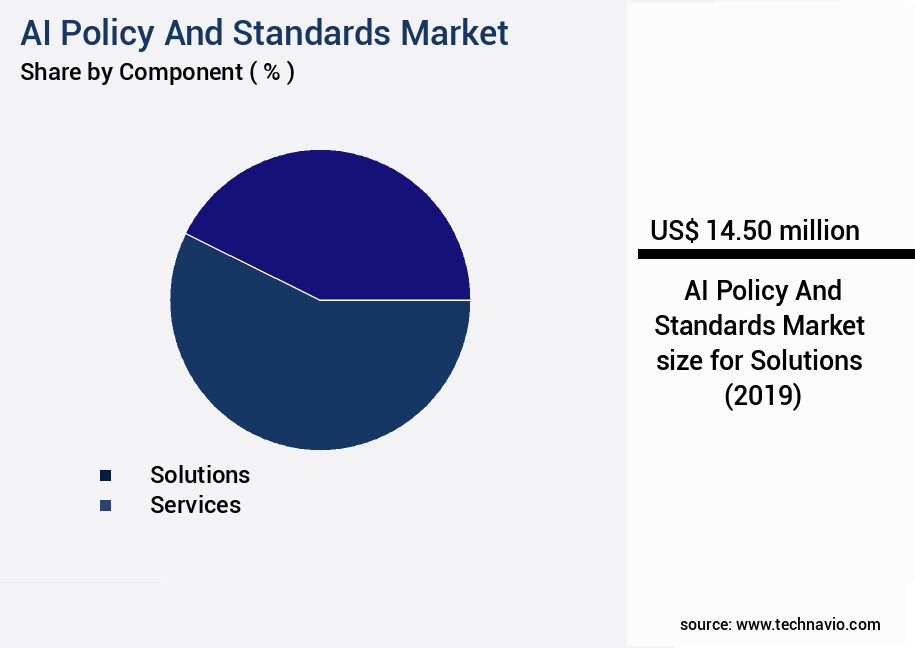
Request Free Sample
The Solutions segment was valued at USD 14.50 million in 2019 and showed a gradual increase during the forecast period.
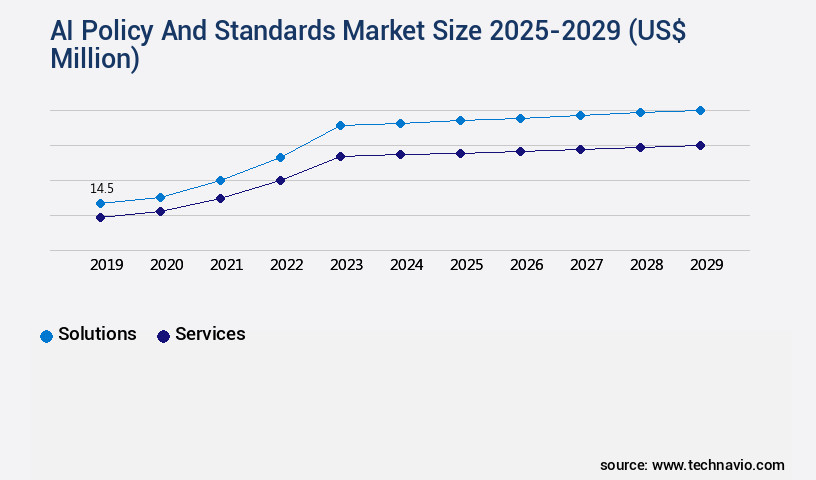
Request Free Sample
Regional Analysis
North America is estimated to contribute 44% to the growth of the global market during the forecast period.Technavio's analysts have elaborately explained the regional trends and drivers that shape the market during the forecast period.
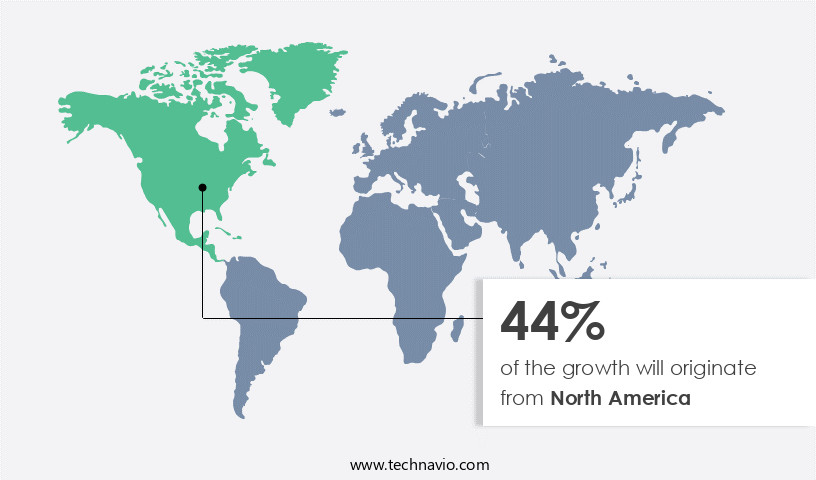
See How AI Policy And Standards Market Demand is Rising in North America Request Free Sample
The market is witnessing significant evolution, with North America, specifically the United States and Canada, leading the charge. This regional market's maturity stems from a unique blend of factors, including influential government guidance, a litigious environment, a concentration of technology developers, and substantial private sector investment. The United States has adopted a sector-specific and innovation-friendly approach, but recent federal actions have created a favorable climate for market growth. A notable milestone was the October 2023 White House Executive Order on Safe, Secure, and Trustworthy Artificial Intelligence. European countries follow closely, with the European Union's General Data Protection Regulation (GDPR) and Artificial Intelligence Act setting stringent standards for AI development and deployment.
These regulations have driven the European market's growth, with the region accounting for over 30% of the global market share.
Market Dynamics
Our researchers analyzed the data with 2024 as the base year, along with the key drivers, trends, and challenges. A holistic analysis of drivers will help companies refine their marketing strategies to gain a competitive advantage.
The market is experiencing significant growth as businesses and governments seek to mitigate algorithmic bias in AI systems, implement data privacy regulations, and develop ethical AI frameworks for specific applications. This market encompasses a range of solutions designed to promote responsible AI development through best practices, measuring fairness using appropriate metrics, and establishing model transparency standards. Key areas of focus include designing effective accountability mechanisms, conducting comprehensive risk assessments, defining and enforcing safety guidelines, and creating robust governance structures. To ensure model transparency, organizations are applying explainable AI techniques and developing interpretability methods for complex models.
Bias detection methods are being integrated into AI development processes to prevent discriminatory outcomes. AI compliance frameworks are being implemented to ensure adherence to regulations and industry standards. Defining auditing procedures and testing the robustness of AI models are essential components of this market, as is establishing security protocols to protect against potential threats. Data privacy is a major concern, with organizations applying data anonymization methods to protect sensitive information. Model validation techniques are used to ensure AI accuracy and reliability. The market also includes the development of ethical AI frameworks, which address issues such as transparency, accountability, and human oversight. In summary, The market is a dynamic and evolving landscape, focused on ensuring the responsible development and deployment of AI systems. It encompasses a range of solutions aimed at mitigating bias, implementing regulations, promoting transparency, and ensuring safety and security.
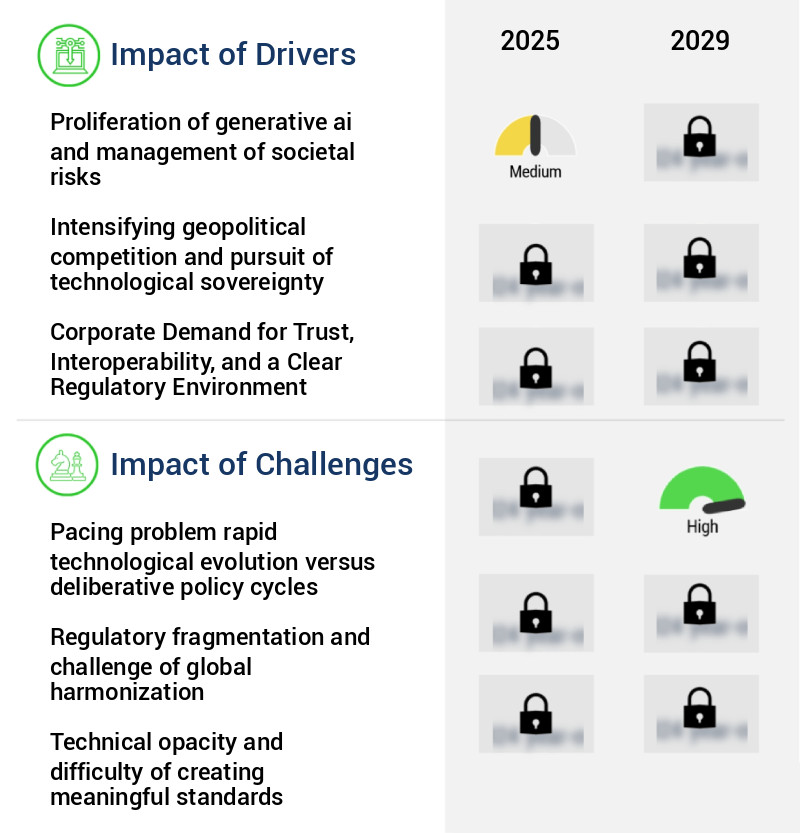
What are the key market drivers leading to the rise in the adoption of AI Policy And Standards Industry?
- The proliferation of generative AI and the concurrent management of associated societal risks serve as the primary market driver.
- The market is experiencing a significant evolution due to the increasing mainstream adoption of advanced generative AI systems. Prior to 2023, AI discussions primarily revolved around theoretical risks and future implications. However, with the public release and rapid adoption of tools like OpenAI ChatGPT and Midjourney, the societal risks of AI have become immediate and tangible, necessitating swift governmental and regulatory responses. This shift from academic to real-world concerns has catalyzed a global effort to establish rules of the road for AI use.
- According to recent estimates, the market is projected to grow substantially, with key sectors such as healthcare, finance, and education expected to invest heavily in AI governance. The need for clear guidelines and standards is particularly pressing in these sectors, where AI applications can significantly impact individual privacy, safety, and ethical considerations.
What are the market trends shaping the AI Policy And Standards Industry?
- The operationalization of ethics signifies a transition from abstract principles to concrete governance mechanisms. This trend is gaining momentum in the market.
- The market is undergoing a significant transformation, shifting from abstract ethical principles to the development of operational governance mechanisms. Previously, the discourse revolved around non-binding lists of principles, such as fairness, accountability, and transparency. However, recent trends indicate a growing recognition that these principles necessitate tangible tools for implementation, verification, and enforcement. As a result, there has been an increase in the establishment of national safety institutes, regulatory sandboxes, and mandatory impact assessment frameworks.
- These mechanisms aim to translate theoretical ethics into measurable and auditable practices, giving rise to a new and sophisticated market for AI assurance services. This trend underscores the importance of concrete, actionable steps in the realm of AI policy and standards.
What challenges does the AI Policy And Standards Industry face during its growth?
- The rapid technological evolution in the industry poses a significant challenge as it outpaces deliberative policy cycles, potentially hindering industry growth.
- The market is experiencing a significant evolution, as the rapid advancement of artificial intelligence (AI) technology outpaces the deliberative process of governmental policymaking and standards creation. This discrepancy between the exponential growth of AI capabilities and the methodical pace of regulation results in a continuous gap, where emerging AI risks and applications surface before regulatory frameworks can be established. This reactive approach to policy-making necessitates governments to address issues that have already gained considerable societal traction, rather than proactively shaping the technology's trajectory. According to recent studies, the global AI market is projected to reach a value of over USD300 billion by 2026, representing a substantial increase from its current size.
- Meanwhile, the market is estimated to grow at a steady pace, with some forecasts suggesting it could reach USD10 billion by the same year. The importance of addressing the regulatory challenges surrounding AI is underscored by the fact that over 64% of businesses worldwide have already implemented AI in some capacity, while 31% plan to do so within the next 12 months.
Exclusive Technavio Analysis on Customer Landscape
The ai policy and standards market forecasting report includes the adoption lifecycle of the market, covering from the innovator's stage to the laggard's stage. It focuses on adoption rates in different regions based on penetration. Furthermore, the ai policy and standards market report also includes key purchase criteria and drivers of price sensitivity to help companies evaluate and develop their market growth analysis strategies.
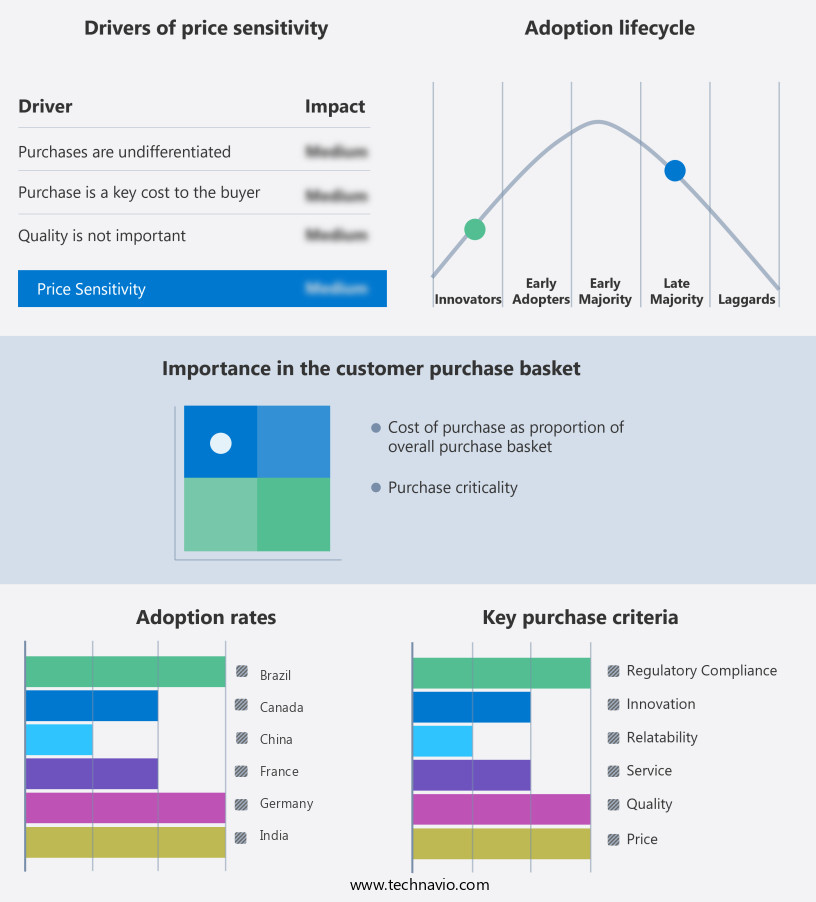
Customer Landscape of AI Policy And Standards Industry
Competitive Landscape
Companies are implementing various strategies, such as strategic alliances, ai policy and standards market forecast, partnerships, mergers and acquisitions, geographical expansion, and product/service launches, to enhance their presence in the industry.
Accenture PLC - This company specializes in an AI framework, emphasizing empathy, fairness, and transparency. It incorporates cross-functional governance and risk management for responsible industry-wide AI scaling, ensuring ethical and equitable application.
The industry research and growth report includes detailed analyses of the competitive landscape of the market and information about key companies, including:
- Accenture PLC
- Amazon Web Services Inc.
- Credo AI
- DataRobot Inc.
- Fair Isaac Corp.
- Google LLC
- H2O.ai Inc.
- International Business Machines Corp.
- Meta Platforms Inc.
- Microsoft Corp.
- NTT DATA Corp.
- OneTrust LLC
- Oracle Corp.
- pymetrics Inc.
- QlikTech International AB
- Salesforce Inc.
- SAP SE
- SAS Institute Inc.
- Tata Consultancy Services Ltd.
- TIBCO Software Inc.
Qualitative and quantitative analysis of companies has been conducted to help clients understand the wider business environment as well as the strengths and weaknesses of key industry players. Data is qualitatively analyzed to categorize companies as pure play, category-focused, industry-focused, and diversified; it is quantitatively analyzed to categorize companies as dominant, leading, strong, tentative, and weak.
Recent Development and News in AI Policy And Standards Market
- In January 2024, the International Organization for Standardization (ISO) and the International Electrotechnical Commission (IEC) jointly published ISO/IEC 23247:2024, the first international standard for artificial intelligence (AI) ethics and transparency (ISO, 2024). This standard aims to provide a framework for organizations to develop and implement ethical AI systems.
- In March 2024, Microsoft and IBM announced a strategic partnership to collaborate on AI policy and standards, with a focus on responsible AI usage and ethical AI development (Microsoft, 2024). They pledged to work together on research, advocacy, and industry collaboration to promote AI transparency and accountability.
- In May 2024, the European Union (EU) passed the Artificial Intelligence Act, a landmark regulation setting guidelines for the development, deployment, and use of AI systems within the EU market (European Parliament, 2024). This legislation includes provisions for risk assessment, transparency, and human oversight, as well as potential restrictions on high-risk AI applications.
- In April 2025, Google and Amazon, two major players in the AI market, jointly invested USD1 billion in the Partnership on AI, a nonprofit organization dedicated to advancing AI research, ethics, and best practices (Partnership on AI, 2025). This significant investment underscores their commitment to responsible AI development and collaboration with other industry leaders.
Dive into Technavio's robust research methodology, blending expert interviews, extensive data synthesis, and validated models for unparalleled AI Policy And Standards Market insights. See full methodology.
|
Market Scope
|
|
Report Coverage
|
Details
|
|
Page number
|
239
|
|
Base year
|
2024
|
|
Historic period
|
2019-2023 |
|
Forecast period
|
2025-2029
|
|
Growth momentum & CAGR
|
Accelerate at a CAGR of 38.6%
|
|
Market growth 2025-2029
|
USD 377.8 million
|
|
Market structure
|
Fragmented
|
|
YoY growth 2024-2025(%)
|
36.3
|
|
Key countries
|
US, China, Germany, Canada, UK, Japan, France, India, Brazil, and Italy
|
|
Competitive landscape
|
Leading Companies, Market Positioning of Companies, Competitive Strategies, and Industry Risks
|
Request Free Sample
Research Analyst Overview
- The market continues to evolve, reflecting the dynamic nature of artificial intelligence (AI) technology and its expanding applications across various sectors. AI system design and implementation necessitate adherence to ethical and fairness metrics, ensuring accountability mechanisms and AI value alignment. Human-in-the-loop systems bridge the gap between AI and human decision-making, necessitating AI ethics education and governance structures. AI policy implementation involves standard development, regulatory landscape, and legal compliance. Explainable AI techniques facilitate model transparency, enabling AI decision-making to be understood and audited. Model validation techniques and safety guidelines are essential for robustness testing and impact assessment.
- Compliance frameworks, data privacy regulations, and security protocols are integral to AI system deployment. Data anonymization methods and algorithmic bias mitigation are crucial for responsible AI development. Model explainability tools and ethical AI frameworks contribute to model transparency and fairness. For instance, a leading e-commerce company reported a 25% increase in sales after implementing an explainable AI model for product recommendations, enhancing user trust and engagement. The global AI market is projected to grow by over 20% annually, driven by ongoing advancements in AI technology and its increasing adoption across industries.
What are the Key Data Covered in this AI Policy And Standards Market Research and Growth Report?
-
What is the expected growth of the AI Policy And Standards Market between 2025 and 2029?
-
What segmentation does the market report cover?
-
The report is segmented by Component (Solutions and Services), Deployment (Cloud-based and On-premises), Application (Risk and compliance management, Bias detection and mitigation, Model explainability, Fairness and accountability tools, and Others), and Geography (North America, Europe, APAC, South America, and Middle East and Africa)
-
Which regions are analyzed in the report?
-
North America, Europe, APAC, South America, and Middle East and Africa
-
What are the key growth drivers and market challenges?
-
Who are the major players in the AI Policy And Standards Market?
-
Accenture PLC, Amazon Web Services Inc., Credo AI, DataRobot Inc., Fair Isaac Corp., Google LLC, H2O.ai Inc., International Business Machines Corp., Meta Platforms Inc., Microsoft Corp., NTT DATA Corp., OneTrust LLC, Oracle Corp., pymetrics Inc., QlikTech International AB, Salesforce Inc., SAP SE, SAS Institute Inc., Tata Consultancy Services Ltd., and TIBCO Software Inc.
Market Research Insights
- The market for AI policy and standards is a dynamic and ever-evolving landscape. Two key aspects of this market highlight its significance. First, the demand for AI system security continues to grow, with an estimated 57% of organizations reporting an increase in AI adoption in the past year. Second, the importance of AI safety guidelines and transparency requirements is increasingly recognized, with industry experts predicting that the global AI market will expand at a compound annual growth rate of 40% over the next decade. AI system reliability and regulatory compliance are crucial concerns for organizations implementing AI systems.
- AI model transparency and accountability frameworks are essential for ensuring ethical use and mitigating potential risks. AI data governance and security measures are also vital components of effective AI policy implementation. The integration of algorithmic fairness into AI policy analysis and validation methods is a developing trend, with data privacy protection being a significant concern as AI systems process increasingly sensitive information. AI safety standards and auditing methodologies are being established to address these challenges and ensure the responsible use of AI. These standards cover various aspects, including model validation, ethical guidelines, and policy evaluation.
- As AI continues to permeate various industries, the importance of robust AI policy and standards will only continue to grow.
We can help! Our analysts can customize this AI policy and standards market research report to meet your requirements.
Get in touch
1 Executive Summary
- 1.1 Market overview
- Executive Summary - Chart on Market Overview
- Executive Summary - Data Table on Market Overview
- Executive Summary - Chart on Global Market Characteristics
- Executive Summary - Chart on Market by Geography
- Executive Summary - Chart on Market Segmentation by Component
- Executive Summary - Chart on Market Segmentation by Deployment
- Executive Summary - Chart on Market Segmentation by Application
- Executive Summary - Chart on Incremental Growth
- Executive Summary - Data Table on Incremental Growth
- Executive Summary - Chart on Company Market Positioning
2 Technavio Analysis
- 2.1 Analysis of price sensitivity, lifecycle, customer purchase basket, adoption rates, and purchase criteria
- Analysis of price sensitivity, lifecycle, customer purchase basket, adoption rates, and purchase criteria
- 2.2 Criticality of inputs and Factors of differentiation
- Overview on criticality of inputs and factors of differentiation
- 2.3 Factors of disruption
- Overview on factors of disruption
- 2.4 Impact of drivers and challenges
- Impact of drivers and challenges in 2024 and 2029
3 Market Landscape
- 3.1 Market ecosystem
- Parent Market
- Data Table on - Parent Market
- 3.2 Market characteristics
- Market characteristics analysis
4 Market Sizing
- 4.1 Market definition
- Offerings of companies included in the market definition
- 4.2 Market segment analysis
- 4.4 Market outlook: Forecast for 2024-2029
- Chart on Global - Market size and forecast 2024-2029 ($ million)
- Data Table on Global - Market size and forecast 2024-2029 ($ million)
- Chart on Global Market: Year-over-year growth 2024-2029 (%)
- Data Table on Global Market: Year-over-year growth 2024-2029 (%)
5 Historic Market Size
- 5.1 Global AI Policy And Standards Market 2019 - 2023
- Historic Market Size - Data Table on Global AI Policy And Standards Market 2019 - 2023 ($ million)
- 5.2 Component segment analysis 2019 - 2023
- Historic Market Size - Component Segment 2019 - 2023 ($ million)
- 5.3 Deployment segment analysis 2019 - 2023
- Historic Market Size - Deployment Segment 2019 - 2023 ($ million)
- 5.4 Application segment analysis 2019 - 2023
- Historic Market Size - Application Segment 2019 - 2023 ($ million)
- 5.5 Geography segment analysis 2019 - 2023
- Historic Market Size - Geography Segment 2019 - 2023 ($ million)
- 5.6 Country segment analysis 2019 - 2023
- Historic Market Size - Country Segment 2019 - 2023 ($ million)
6 Five Forces Analysis
- 6.1 Five forces summary
- Five forces analysis - Comparison between 2024 and 2029
- 6.2 Bargaining power of buyers
- Bargaining power of buyers - Impact of key factors 2024 and 2029
- 6.3 Bargaining power of suppliers
- Bargaining power of suppliers - Impact of key factors in 2024 and 2029
- 6.4 Threat of new entrants
- Threat of new entrants - Impact of key factors in 2024 and 2029
- 6.5 Threat of substitutes
- Threat of substitutes - Impact of key factors in 2024 and 2029
- 6.6 Threat of rivalry
- Threat of rivalry - Impact of key factors in 2024 and 2029
- 6.7 Market condition
- Chart on Market condition - Five forces 2024 and 2029
7 Market Segmentation by Component
- 7.1 Market segments
- Chart on Component - Market share 2024-2029 (%)
- Data Table on Component - Market share 2024-2029 (%)
- 7.2 Comparison by Component
- Chart on Comparison by Component
- Data Table on Comparison by Component
- 7.3 Solutions - Market size and forecast 2024-2029
- Chart on Solutions - Market size and forecast 2024-2029 ($ million)
- Data Table on Solutions - Market size and forecast 2024-2029 ($ million)
- Chart on Solutions - Year-over-year growth 2024-2029 (%)
- Data Table on Solutions - Year-over-year growth 2024-2029 (%)
- 7.4 Services - Market size and forecast 2024-2029
- Chart on Services - Market size and forecast 2024-2029 ($ million)
- Data Table on Services - Market size and forecast 2024-2029 ($ million)
- Chart on Services - Year-over-year growth 2024-2029 (%)
- Data Table on Services - Year-over-year growth 2024-2029 (%)
- 7.5 Market opportunity by Component
- Market opportunity by Component ($ million)
- Data Table on Market opportunity by Component ($ million)
8 Market Segmentation by Deployment
- 8.1 Market segments
- Chart on Deployment - Market share 2024-2029 (%)
- Data Table on Deployment - Market share 2024-2029 (%)
- 8.2 Comparison by Deployment
- Chart on Comparison by Deployment
- Data Table on Comparison by Deployment
- 8.3 On premises - Market size and forecast 2024-2029
- Chart on On premises - Market size and forecast 2024-2029 ($ million)
- Data Table on On premises - Market size and forecast 2024-2029 ($ million)
- Chart on On premises - Year-over-year growth 2024-2029 (%)
- Data Table on On premises - Year-over-year growth 2024-2029 (%)
- 8.4 Cloud based - Market size and forecast 2024-2029
- Chart on Cloud based - Market size and forecast 2024-2029 ($ million)
- Data Table on Cloud based - Market size and forecast 2024-2029 ($ million)
- Chart on Cloud based - Year-over-year growth 2024-2029 (%)
- Data Table on Cloud based - Year-over-year growth 2024-2029 (%)
- 8.5 Market opportunity by Deployment
- Market opportunity by Deployment ($ million)
- Data Table on Market opportunity by Deployment ($ million)
9 Market Segmentation by Application
- 9.1 Market segments
- Chart on Application - Market share 2024-2029 (%)
- Data Table on Application - Market share 2024-2029 (%)
- 9.2 Comparison by Application
- Chart on Comparison by Application
- Data Table on Comparison by Application
- 9.3 Risk and compliance management - Market size and forecast 2024-2029
- Chart on Risk and compliance management - Market size and forecast 2024-2029 ($ million)
- Data Table on Risk and compliance management - Market size and forecast 2024-2029 ($ million)
- Chart on Risk and compliance management - Year-over-year growth 2024-2029 (%)
- Data Table on Risk and compliance management - Year-over-year growth 2024-2029 (%)
- 9.4 Bias detection and mitigation - Market size and forecast 2024-2029
- Chart on Bias detection and mitigation - Market size and forecast 2024-2029 ($ million)
- Data Table on Bias detection and mitigation - Market size and forecast 2024-2029 ($ million)
- Chart on Bias detection and mitigation - Year-over-year growth 2024-2029 (%)
- Data Table on Bias detection and mitigation - Year-over-year growth 2024-2029 (%)
- 9.5 Model explainability - Market size and forecast 2024-2029
- Chart on Model explainability - Market size and forecast 2024-2029 ($ million)
- Data Table on Model explainability - Market size and forecast 2024-2029 ($ million)
- Chart on Model explainability - Year-over-year growth 2024-2029 (%)
- Data Table on Model explainability - Year-over-year growth 2024-2029 (%)
- 9.6 Fairness and accountability tools - Market size and forecast 2024-2029
- Chart on Fairness and accountability tools - Market size and forecast 2024-2029 ($ million)
- Data Table on Fairness and accountability tools - Market size and forecast 2024-2029 ($ million)
- Chart on Fairness and accountability tools - Year-over-year growth 2024-2029 (%)
- Data Table on Fairness and accountability tools - Year-over-year growth 2024-2029 (%)
- 9.7 Others - Market size and forecast 2024-2029
- Chart on Others - Market size and forecast 2024-2029 ($ million)
- Data Table on Others - Market size and forecast 2024-2029 ($ million)
- Chart on Others - Year-over-year growth 2024-2029 (%)
- Data Table on Others - Year-over-year growth 2024-2029 (%)
- 9.8 Market opportunity by Application
- Market opportunity by Application ($ million)
- Data Table on Market opportunity by Application ($ million)
10 Customer Landscape
- 10.1 Customer landscape overview
- Analysis of price sensitivity, lifecycle, customer purchase basket, adoption rates, and purchase criteria
11 Geographic Landscape
- 11.1 Geographic segmentation
- Chart on Market share by geography 2024-2029 (%)
- Data Table on Market share by geography 2024-2029 (%)
- 11.2 Geographic comparison
- Chart on Geographic comparison
- Data Table on Geographic comparison
- 11.3 North America - Market size and forecast 2024-2029
- Chart on North America - Market size and forecast 2024-2029 ($ million)
- Data Table on North America - Market size and forecast 2024-2029 ($ million)
- Chart on North America - Year-over-year growth 2024-2029 (%)
- Data Table on North America - Year-over-year growth 2024-2029 (%)
- 11.4 Europe - Market size and forecast 2024-2029
- Chart on Europe - Market size and forecast 2024-2029 ($ million)
- Data Table on Europe - Market size and forecast 2024-2029 ($ million)
- Chart on Europe - Year-over-year growth 2024-2029 (%)
- Data Table on Europe - Year-over-year growth 2024-2029 (%)
- 11.5 APAC - Market size and forecast 2024-2029
- Chart on APAC - Market size and forecast 2024-2029 ($ million)
- Data Table on APAC - Market size and forecast 2024-2029 ($ million)
- Chart on APAC - Year-over-year growth 2024-2029 (%)
- Data Table on APAC - Year-over-year growth 2024-2029 (%)
- 11.6 South America - Market size and forecast 2024-2029
- Chart on South America - Market size and forecast 2024-2029 ($ million)
- Data Table on South America - Market size and forecast 2024-2029 ($ million)
- Chart on South America - Year-over-year growth 2024-2029 (%)
- Data Table on South America - Year-over-year growth 2024-2029 (%)
- 11.7 Middle East and Africa - Market size and forecast 2024-2029
- Chart on Middle East and Africa - Market size and forecast 2024-2029 ($ million)
- Data Table on Middle East and Africa - Market size and forecast 2024-2029 ($ million)
- Chart on Middle East and Africa - Year-over-year growth 2024-2029 (%)
- Data Table on Middle East and Africa - Year-over-year growth 2024-2029 (%)
- 11.8 US - Market size and forecast 2024-2029
- Chart on US - Market size and forecast 2024-2029 ($ million)
- Data Table on US - Market size and forecast 2024-2029 ($ million)
- Chart on US - Year-over-year growth 2024-2029 (%)
- Data Table on US - Year-over-year growth 2024-2029 (%)
- 11.9 China - Market size and forecast 2024-2029
- Chart on China - Market size and forecast 2024-2029 ($ million)
- Data Table on China - Market size and forecast 2024-2029 ($ million)
- Chart on China - Year-over-year growth 2024-2029 (%)
- Data Table on China - Year-over-year growth 2024-2029 (%)
- 11.10 Germany - Market size and forecast 2024-2029
- Chart on Germany - Market size and forecast 2024-2029 ($ million)
- Data Table on Germany - Market size and forecast 2024-2029 ($ million)
- Chart on Germany - Year-over-year growth 2024-2029 (%)
- Data Table on Germany - Year-over-year growth 2024-2029 (%)
- 11.11 Canada - Market size and forecast 2024-2029
- Chart on Canada - Market size and forecast 2024-2029 ($ million)
- Data Table on Canada - Market size and forecast 2024-2029 ($ million)
- Chart on Canada - Year-over-year growth 2024-2029 (%)
- Data Table on Canada - Year-over-year growth 2024-2029 (%)
- 11.12 UK - Market size and forecast 2024-2029
- Chart on UK - Market size and forecast 2024-2029 ($ million)
- Data Table on UK - Market size and forecast 2024-2029 ($ million)
- Chart on UK - Year-over-year growth 2024-2029 (%)
- Data Table on UK - Year-over-year growth 2024-2029 (%)
- 11.13 Japan - Market size and forecast 2024-2029
- Chart on Japan - Market size and forecast 2024-2029 ($ million)
- Data Table on Japan - Market size and forecast 2024-2029 ($ million)
- Chart on Japan - Year-over-year growth 2024-2029 (%)
- Data Table on Japan - Year-over-year growth 2024-2029 (%)
- 11.14 France - Market size and forecast 2024-2029
- Chart on France - Market size and forecast 2024-2029 ($ million)
- Data Table on France - Market size and forecast 2024-2029 ($ million)
- Chart on France - Year-over-year growth 2024-2029 (%)
- Data Table on France - Year-over-year growth 2024-2029 (%)
- 11.15 India - Market size and forecast 2024-2029
- Chart on India - Market size and forecast 2024-2029 ($ million)
- Data Table on India - Market size and forecast 2024-2029 ($ million)
- Chart on India - Year-over-year growth 2024-2029 (%)
- Data Table on India - Year-over-year growth 2024-2029 (%)
- 11.16 Brazil - Market size and forecast 2024-2029
- Chart on Brazil - Market size and forecast 2024-2029 ($ million)
- Data Table on Brazil - Market size and forecast 2024-2029 ($ million)
- Chart on Brazil - Year-over-year growth 2024-2029 (%)
- Data Table on Brazil - Year-over-year growth 2024-2029 (%)
- 11.17 Italy - Market size and forecast 2024-2029
- Chart on Italy - Market size and forecast 2024-2029 ($ million)
- Data Table on Italy - Market size and forecast 2024-2029 ($ million)
- Chart on Italy - Year-over-year growth 2024-2029 (%)
- Data Table on Italy - Year-over-year growth 2024-2029 (%)
- 11.18 Market opportunity by geography
- Market opportunity by geography ($ million)
- Data Tables on Market opportunity by geography ($ million)
12 Drivers, Challenges, and Opportunity/Restraints
- 12.3 Impact of drivers and challenges
- Impact of drivers and challenges in 2024 and 2029
- 12.4 Market opportunities/restraints
13 Competitive Landscape
- 13.2 Competitive Landscape
- Overview on criticality of inputs and factors of differentiation
- 13.3 Landscape disruption
- Overview on factors of disruption
- 13.4 Industry risks
- Impact of key risks on business
14 Competitive Analysis
- 14.2 Company ranking index
- 14.3 Market positioning of companies
- Matrix on companies position and classification
- 14.4 Accenture PLC
- Accenture PLC - Overview
- Accenture PLC - Business segments
- Accenture PLC - Key news
- Accenture PLC - Key offerings
- Accenture PLC - Segment focus
- SWOT
- 14.5 Amazon Web Services Inc.
- Amazon Web Services Inc. - Overview
- Amazon Web Services Inc. - Product / Service
- Amazon Web Services Inc. - Key news
- Amazon Web Services Inc. - Key offerings
- SWOT
- 14.6 Fair Isaac Corp.
- Fair Isaac Corp. - Overview
- Fair Isaac Corp. - Business segments
- Fair Isaac Corp. - Key news
- Fair Isaac Corp. - Key offerings
- Fair Isaac Corp. - Segment focus
- SWOT
- 14.7 Google LLC
- Google LLC - Overview
- Google LLC - Product / Service
- Google LLC - Key offerings
- SWOT
- 14.8 H2O.ai Inc.
- H2O.ai Inc. - Overview
- H2O.ai Inc. - Product / Service
- H2O.ai Inc. - Key offerings
- SWOT
- 14.9 International Business Machines Corp.
- International Business Machines Corp. - Overview
- International Business Machines Corp. - Business segments
- International Business Machines Corp. - Key news
- International Business Machines Corp. - Key offerings
- International Business Machines Corp. - Segment focus
- SWOT
- 14.10 Meta Platforms Inc.
- Meta Platforms Inc. - Overview
- Meta Platforms Inc. - Business segments
- Meta Platforms Inc. - Key offerings
- Meta Platforms Inc. - Segment focus
- SWOT
- 14.11 Microsoft Corp.
- Microsoft Corp. - Overview
- Microsoft Corp. - Business segments
- Microsoft Corp. - Key news
- Microsoft Corp. - Key offerings
- Microsoft Corp. - Segment focus
- SWOT
- 14.12 NTT DATA Corp.
- NTT DATA Corp. - Overview
- NTT DATA Corp. - Product / Service
- NTT DATA Corp. - Key news
- NTT DATA Corp. - Key offerings
- SWOT
- 14.13 Oracle Corp.
- Oracle Corp. - Overview
- Oracle Corp. - Business segments
- Oracle Corp. - Key news
- Oracle Corp. - Key offerings
- Oracle Corp. - Segment focus
- SWOT
- 14.14 pymetrics Inc.
- pymetrics Inc. - Overview
- pymetrics Inc. - Product / Service
- pymetrics Inc. - Key offerings
- SWOT
- 14.15 Salesforce Inc.
- Salesforce Inc. - Overview
- Salesforce Inc. - Product / Service
- Salesforce Inc. - Key news
- Salesforce Inc. - Key offerings
- SWOT
- 14.16 SAP SE
- SAP SE - Overview
- SAP SE - Business segments
- SAP SE - Key news
- SAP SE - Key offerings
- SAP SE - Segment focus
- SWOT
- 14.17 SAS Institute Inc.
- SAS Institute Inc. - Overview
- SAS Institute Inc. - Product / Service
- SAS Institute Inc. - Key news
- SAS Institute Inc. - Key offerings
- SWOT
- 14.18 TIBCO Software Inc.
- TIBCO Software Inc. - Overview
- TIBCO Software Inc. - Product / Service
- TIBCO Software Inc. - Key offerings
- SWOT
15 Appendix
- 15.2 Inclusions and exclusions checklist
- Inclusions checklist
- Exclusions checklist
- 15.3 Currency conversion rates for US$
- Currency conversion rates for US$
- 15.4 Research methodology
- 15.7 Validation techniques employed for market sizing
- Validation techniques employed for market sizing
- 15.9 360 degree market analysis
- 360 degree market analysis
- 15.10 List of abbreviations







![]() Get the report (PDF) sent to your email within minutes.
Get the report (PDF) sent to your email within minutes.
Complimentary full Excel data with your report purchase.